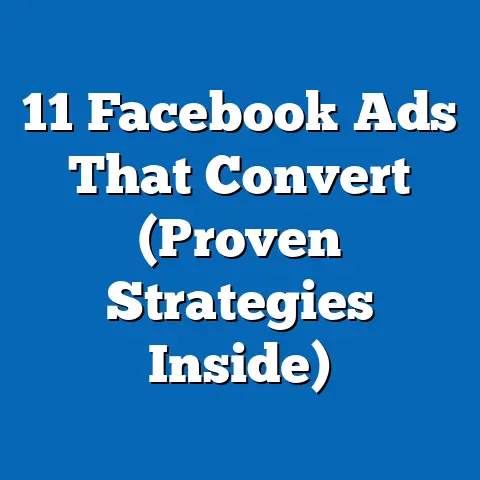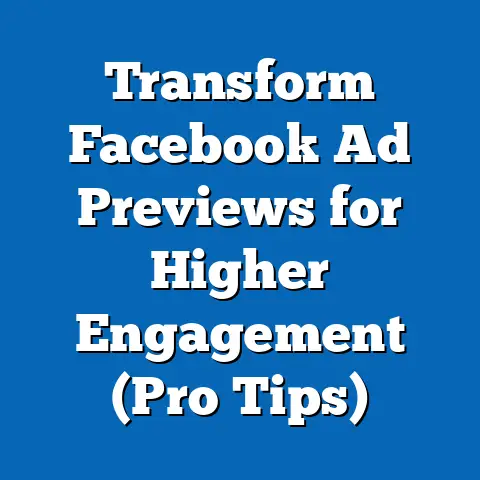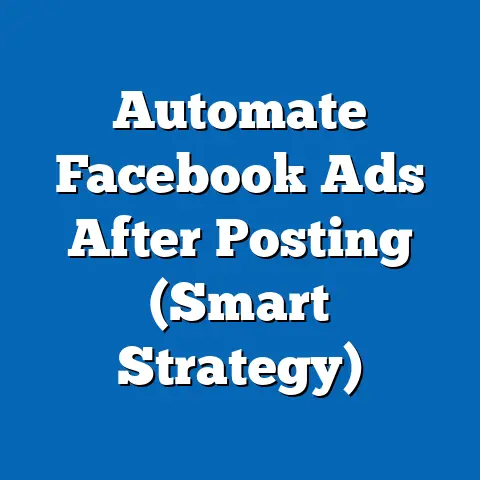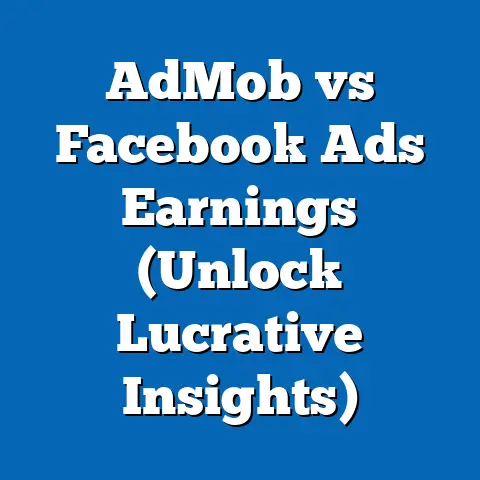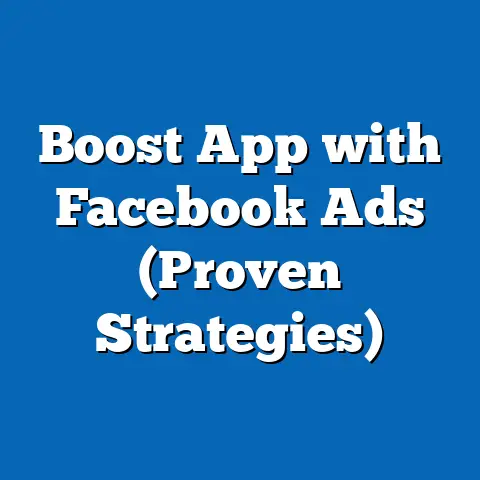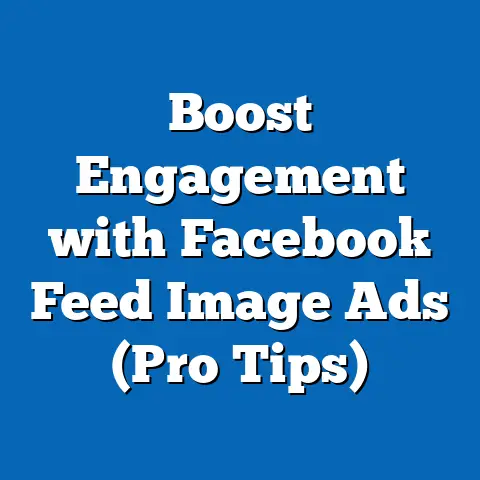Charge for Facebook Ads Like a Pro (Expert Pricing Strategies)
Understanding the Value of Facebook Ads
Facebook ads aren’t just about throwing money at a platform and hoping for the best. They’re a powerful tool when wielded correctly, offering incredible reach and precision targeting. With over 2.9 billion monthly active users, Facebook presents an unparalleled opportunity to connect with potential customers. But it’s not just about the numbers. It’s about the right numbers – the people most likely to convert into loyal customers.
Facebook’s advanced targeting capabilities allow you to pinpoint your ideal audience based on demographics, interests, behaviors, and even custom audiences built from your existing customer data. This precision means you can deliver the right message to the right people at the right time, maximizing your ROI.
My Experience: Early in my career, I made the mistake of underpricing my services. I was so eager to get clients that I didn’t fully articulate the value I brought to the table. As a result, I attracted clients who were primarily focused on price, not results. This led to a lot of stress and dissatisfaction on both sides. Once I learned to confidently communicate the value of my strategic approach and tailored solutions, I started attracting clients who were willing to pay for quality and expertise, which ultimately led to better results and a more fulfilling career.
Takeaway: Facebook ads are a valuable tool, but their true potential is unlocked with strategic expertise. Align your pricing with the value you provide, and focus on attracting clients who appreciate the ROI you can generate.
Market Research and Competitive Analysis
Before you even think about setting your prices, it’s crucial to understand the market landscape. Who are your competitors? What are they charging? What services are they offering? Thorough market research will give you a solid foundation for setting competitive and profitable prices.
Start by identifying your direct competitors – other agencies or freelancers offering similar Facebook ad management services. Look at their websites, social media profiles, and online reviews. Pay attention to:
- Pricing: Are they transparent about their pricing? Do they offer packages? What are their hourly rates or project fees?
- Services: What specific services do they include in their offerings? Do they specialize in a particular niche or industry?
- Value Proposition: What makes them unique? What promises do they make to their clients?
Don’t just look at the prices; analyze the value they’re offering. Are they promising guaranteed results? Do they have case studies or testimonials showcasing their success? This will help you understand how they’re positioning themselves in the market and justify their pricing.
Industry Benchmarks: Beyond your direct competitors, research industry benchmarks for Facebook ad management services. Organizations like HubSpot, Neil Patel Digital, and Social Media Examiner often publish reports and surveys on marketing agency pricing. These benchmarks can give you a general idea of what’s considered a fair price for different services.
My Insight: I once landed a high-paying client simply because I did my homework. I knew exactly what my competitors were charging, and I was able to articulate why my services were worth the premium. I highlighted my experience, my track record of success, and the tailored approach I took to each client’s unique needs. The client appreciated my transparency and my confidence in my value proposition.
Takeaway: Market research and competitive analysis are essential for setting competitive and profitable prices. Understand your competitors, research industry benchmarks, and identify your unique value proposition.
Pricing Models for Facebook Ads
Choosing the right pricing model is crucial for both your profitability and client satisfaction. There’s no one-size-fits-all solution; the best model will depend on your experience, your target market, and the specific services you offer. Here are some common pricing models for Facebook ads:
-
Hourly Rate: This is a straightforward model where you charge clients for each hour you spend working on their campaigns.
- Pros: Easy to track your time, transparent for clients, suitable for projects with unpredictable scope.
- Cons: Can be difficult to estimate total cost, may not incentivize efficiency, clients may be hesitant to approve extra hours.
- When to Use: Ideal for ongoing projects with fluctuating needs or when the scope of work is difficult to define upfront.
-
Flat Fee Per Project: You charge a fixed price for a specific project, such as setting up a new Facebook ad campaign or running a specific promotion.
-
Pros: Predictable income, easy for clients to budget, incentivizes efficiency.
- Cons: Requires accurate estimation of time and resources, may be difficult to adjust for unexpected changes in scope, can be less profitable if the project takes longer than expected.
- When to Use: Best for well-defined projects with a clear scope of work, such as setting up a new ad campaign or creating a specific set of ads.
-
Performance-Based Pricing (e.g., Cost Per Acquisition): You charge clients based on the results you achieve, such as the number of leads generated or sales made.
-
Pros: Highly incentivized to deliver results, attractive to clients, can be very profitable if you’re successful.
- Cons: Risky if you’re not confident in your abilities, requires accurate tracking of conversions, may be difficult to attribute results solely to Facebook ads.
- When to Use: Suitable for clients with clear conversion goals and when you have a strong track record of delivering results. It’s important to clearly define what constitutes a “conversion” and how it will be tracked.
-
Retainer-Based Pricing for Ongoing Services: You charge a fixed monthly fee for ongoing management and optimization of Facebook ad campaigns.
-
Pros: Predictable income, builds long-term relationships with clients, allows for consistent monitoring and optimization.
- Cons: Requires ongoing commitment, may need to adjust fees based on performance or changes in scope, clients may expect constant communication and updates.
- When to Use: Ideal for clients who need ongoing support and optimization of their Facebook ad campaigns.
Hourly Rate: This is a straightforward model where you charge clients for each hour you spend working on their campaigns.
- Pros: Easy to track your time, transparent for clients, suitable for projects with unpredictable scope.
- Cons: Can be difficult to estimate total cost, may not incentivize efficiency, clients may be hesitant to approve extra hours.
- When to Use: Ideal for ongoing projects with fluctuating needs or when the scope of work is difficult to define upfront.
-
Flat Fee Per Project: You charge a fixed price for a specific project, such as setting up a new Facebook ad campaign or running a specific promotion.
-
Pros: Predictable income, easy for clients to budget, incentivizes efficiency.
- Cons: Requires accurate estimation of time and resources, may be difficult to adjust for unexpected changes in scope, can be less profitable if the project takes longer than expected.
- When to Use: Best for well-defined projects with a clear scope of work, such as setting up a new ad campaign or creating a specific set of ads.
-
Performance-Based Pricing (e.g., Cost Per Acquisition): You charge clients based on the results you achieve, such as the number of leads generated or sales made.
-
Pros: Highly incentivized to deliver results, attractive to clients, can be very profitable if you’re successful.
- Cons: Risky if you’re not confident in your abilities, requires accurate tracking of conversions, may be difficult to attribute results solely to Facebook ads.
- When to Use: Suitable for clients with clear conversion goals and when you have a strong track record of delivering results. It’s important to clearly define what constitutes a “conversion” and how it will be tracked.
-
Retainer-Based Pricing for Ongoing Services: You charge a fixed monthly fee for ongoing management and optimization of Facebook ad campaigns.
-
Pros: Predictable income, builds long-term relationships with clients, allows for consistent monitoring and optimization.
- Cons: Requires ongoing commitment, may need to adjust fees based on performance or changes in scope, clients may expect constant communication and updates.
- When to Use: Ideal for clients who need ongoing support and optimization of their Facebook ad campaigns.
Flat Fee Per Project: You charge a fixed price for a specific project, such as setting up a new Facebook ad campaign or running a specific promotion.
Pros: Predictable income, easy for clients to budget, incentivizes efficiency.
Performance-Based Pricing (e.g., Cost Per Acquisition): You charge clients based on the results you achieve, such as the number of leads generated or sales made.
Pros: Highly incentivized to deliver results, attractive to clients, can be very profitable if you’re successful.
Retainer-Based Pricing for Ongoing Services: You charge a fixed monthly fee for ongoing management and optimization of Facebook ad campaigns.
Pros: Predictable income, builds long-term relationships with clients, allows for consistent monitoring and optimization.
My Recommendation: I personally prefer retainer-based pricing for most of my clients. It allows me to build long-term relationships, provide consistent value, and focus on optimizing their campaigns for maximum ROI. However, I also offer flat fees for specific projects like campaign setup or ad creative design.
Takeaway: Choose the pricing model that best aligns with your experience, your target market, and the specific services you offer. Consider the pros and cons of each model and be prepared to adapt your pricing strategy as your business evolves.
Cost Considerations
Before you can set your prices, you need to understand your costs. This includes not just your ad spend, but also your management fees, creative production costs, and overhead expenses.
- Ad Spend: This is the amount of money you’ll spend directly on Facebook ads. It’s usually the largest cost component.
- Management Fees: This is the fee you charge for managing the ad campaigns, including strategy development, targeting, ad creation, optimization, and reporting.
- Creative Production Costs: This includes the cost of creating ad creatives, such as images, videos, and ad copy.
- Overhead Expenses: This includes your business expenses, such as rent, software subscriptions, marketing, and administrative costs.
Calculating Your Total Cost:
Here’s a simple formula for calculating the total cost of delivering Facebook ad services to your clients:
Total Cost = Ad Spend + (Hourly Rate x Hours Worked) + Creative Costs + (Overhead Allocation x Project Duration)
For example, let’s say you’re running a Facebook ad campaign for a client with a monthly ad spend of $1,000. You estimate that you’ll spend 20 hours per month managing the campaign, and your hourly rate is $75. The creative costs are $200, and your overhead allocation for the project is $100.
Total Cost = $1,000 + ($75 x 20) + $200 + $100 = $2,800
This means your total cost for delivering the Facebook ad services is $2,800.
Profit Margin: After calculating your total cost, you need to factor in your desired profit margin. This is the percentage of revenue you want to keep as profit. A typical profit margin for marketing agencies is between 20% and 30%.
To calculate your pricing, simply divide your total cost by (1 – profit margin).
Pricing = Total Cost / (1 - Profit Margin)
Using the example above, if you want a profit margin of 25%, your pricing would be:
Pricing = $2,800 / (1 - 0.25) = $3,733.33
This means you should charge your client at least $3,733.33 to cover your costs and achieve your desired profit margin.
My Strategy: I always build a buffer into my cost estimates to account for unexpected challenges or changes in scope. It’s better to overestimate your costs and come in under budget than to underestimate and end up losing money.
Takeaway: Understand your costs, factor in your desired profit margin, and build a buffer for unexpected challenges. This will help you set profitable prices that ensure the long-term sustainability of your business.
Creating Packages and Tiered Pricing
Offering packages and tiered pricing can be a great way to cater to different client segments and increase your overall revenue. Packages bundle together related services at a discounted price, while tiered pricing offers different levels of service at different price points.
Package Examples:
- Basic Package: Includes campaign setup, basic targeting, and ad creation.
- Standard Package: Includes everything in the Basic Package, plus advanced targeting, A/B testing, and monthly reporting.
- Premium Package: Includes everything in the Standard Package, plus custom audience creation, retargeting campaigns, and dedicated account management.
Tiered Pricing Examples:
- Tier 1: For small businesses with limited budgets. Includes basic campaign setup and limited ongoing management.
- Tier 2: For medium-sized businesses with moderate budgets. Includes more advanced targeting, A/B testing, and regular reporting.
- Tier 3: For large enterprises with significant budgets. Includes custom audience creation, retargeting campaigns, dedicated account management, and strategic consulting.
Benefits of Packages and Tiered Pricing:
- Increased Revenue: By offering different options, you can attract a wider range of clients and increase your overall revenue.
- Simplified Sales Process: Packages and tiered pricing make it easier for clients to understand your offerings and make a decision.
- Improved Client Satisfaction: By providing options that meet their specific needs and budgets, you can improve client satisfaction and build long-term relationships.
My Approach: I always start by understanding my clients’ goals, budgets, and needs. Then, I present them with a few different packages or tiered pricing options that are tailored to their specific situation. This allows them to choose the option that best fits their needs and budget.
Takeaway: Packages and tiered pricing can be a great way to attract a wider range of clients, simplify your sales process, and improve client satisfaction. Tailor your packages and pricing to meet the specific needs and budgets of your target market.
Communicating Value to Clients
It’s not enough to offer great services at a fair price; you also need to effectively communicate the value of your services to potential clients. This means highlighting the ROI you can generate, showcasing your expertise, and building trust.
- Case Studies: Case studies are one of the most powerful tools for demonstrating the value of your services. Showcase your success stories, highlighting the specific results you achieved for your clients. Include metrics like increased website traffic, leads generated, sales made, and ROI achieved.
- Testimonials: Testimonials from satisfied clients can be incredibly persuasive. Ask your clients to provide testimonials highlighting the positive impact your services have had on their business.
- Success Stories: Share success stories on your website, social media profiles, and in your marketing materials. These stories should focus on the specific challenges your clients faced, the solutions you provided, and the results you achieved.
Articulating the Benefits of Your Pricing Structure:
When discussing pricing with potential clients, focus on the benefits they’ll receive, not just the cost. Explain how your pricing structure allows you to provide the best possible service and deliver the best possible results.
For example, if you’re using retainer-based pricing, explain that this allows you to provide consistent monitoring, optimization, and support, which ultimately leads to better ROI for the client. If you’re using performance-based pricing, explain that this incentivizes you to deliver results and ensures that the client only pays for success.
My Tip: I always tailor my communication to the specific needs and concerns of each client. I listen carefully to their goals and challenges, and I explain how my services and pricing structure can help them achieve their objectives.
Takeaway: Effectively communicate the value of your services by showcasing your expertise, highlighting your success stories, and articulating the benefits of your pricing structure. Build trust by being transparent, honest, and responsive to your clients’ needs.
Negotiation Tactics for Pricing
Negotiation is a natural part of the sales process, and it’s important to be prepared to discuss pricing with potential clients. Here are some effective negotiation tactics:
- Know Your Value: Before you start negotiating, be clear on the value you bring to the table. Understand your costs, your profit margin, and your unique selling proposition.
- Listen Carefully: Pay attention to the client’s needs, concerns, and budget. This will help you tailor your offer to their specific situation.
- Be Flexible: Be prepared to make concessions, but don’t compromise on your value. Consider offering a discount, adjusting the scope of work, or providing additional services.
- Focus on Value, Not Price: Remind the client of the value you’re providing, the ROI you can generate, and the benefits they’ll receive.
- Be Confident: Project confidence in your abilities and your pricing. If you believe in your value, the client is more likely to believe in it too.
Handling Objections and Pushback:
Be prepared to handle objections and pushback on pricing. Here are some common objections and how to address them:
- “Your price is too high.” Acknowledge their concern and reiterate the value you’re providing. Explain how your services can help them achieve their goals and generate a positive ROI.
- “I can get the same service for less elsewhere.” Ask them to compare the specific services and value offered. Highlight your unique selling proposition and the benefits of working with you.
- “I don’t have the budget for that.” Explore options for adjusting the scope of work or offering a payment plan. Focus on finding a solution that meets their needs and budget.
My Approach: I always approach negotiations with a win-win mindset. I want to find a solution that works for both me and the client. I’m willing to be flexible and make concessions, but I never compromise on my value.
Takeaway: Be prepared to negotiate pricing with potential clients. Know your value, listen carefully, be flexible, and focus on value, not price. Handle objections and pushback with confidence and a win-win mindset.
Monitoring and Adjusting Pricing Over Time
Pricing is not a one-time decision; it’s an ongoing process that requires regular monitoring and adjustment. Market conditions, client feedback, and your own experience will all influence your pricing strategy over time.
- Track Key Performance Indicators (KPIs): Monitor your revenue, profit margin, client acquisition cost, client retention rate, and client satisfaction. These KPIs will give you insights into the success of your pricing strategy.
- Gather Client Feedback: Regularly solicit feedback from your clients on your services and pricing. Ask them what they value most, what they think you could improve, and whether they feel they’re getting a good return on their investment.
- Stay Updated on Market Trends: Keep an eye on industry trends, competitor pricing, and changes in Facebook advertising costs. This will help you identify opportunities to adjust your pricing and stay competitive.
When and How to Raise Prices:
Raising prices can be a difficult decision, but it’s often necessary to maintain profitability and reflect the increasing value of your services. Here are some signs that it may be time to raise your prices:
- High Demand: If you’re consistently booked solid and turning away new clients, it may be time to raise your prices.
- Increased Value: If you’ve added new services, improved your processes, or achieved significant results for your clients, you can justify raising your prices.
- Rising Costs: If your costs have increased, you’ll need to raise your prices to maintain your profit margin.
When raising prices, it’s important to communicate the value you’re providing and give your clients advance notice. Explain why you’re raising prices and how it will benefit them in the long run.
My Experience: I once hesitated to raise my prices because I was afraid of losing clients. However, after tracking my KPIs and gathering client feedback, I realized that I was consistently delivering exceptional results and that my clients were more than willing to pay for the value I provided. When I finally raised my prices, I didn’t lose any clients, and my revenue increased significantly.
Takeaway: Regularly monitor and adjust your pricing strategy based on market conditions, client feedback, and your own experience. Be prepared to raise prices when necessary, but communicate the value you’re providing and give your clients advance notice.
Real-World Examples
Let’s look at some real-world examples of successful advertisers who have implemented expert pricing strategies for Facebook ads:
- Example 1: A Boutique Marketing Agency Specializing in E-commerce: This agency focuses exclusively on e-commerce businesses and offers performance-based pricing. They charge a percentage of the revenue generated from Facebook ads, which incentivizes them to deliver exceptional results. They have a strong track record of success and are able to attract high-paying clients who are willing to pay for performance.
- Example 2: A Freelance Facebook Ad Manager Targeting Small Businesses: This freelancer offers tiered pricing based on the level of service provided. They have a basic package for small businesses with limited budgets, a standard package for medium-sized businesses, and a premium package for larger businesses. This allows them to cater to a wide range of clients and maximize their revenue.
- Example 3: A Large Marketing Agency Offering Comprehensive Digital Marketing Solutions: This agency offers retainer-based pricing for ongoing Facebook ad management services. They provide a comprehensive suite of services, including strategy development, targeting, ad creation, optimization, and reporting. They build long-term relationships with their clients and provide consistent value over time.
Analysis:
These examples demonstrate that there’s no one-size-fits-all approach to pricing. The best strategy will depend on your target market, your services, and your business model. However, all of these successful advertisers have a few things in common:
- They understand their value: They know what they’re worth and they’re confident in their pricing.
- They communicate their value effectively: They showcase their expertise, highlight their success stories, and articulate the benefits of their pricing structure.
- They monitor and adjust their pricing over time: They track their KPIs, gather client feedback, and stay updated on market trends.
My Advice: Learn from these examples, but don’t be afraid to experiment and find what works best for you. The key is to be strategic, thoughtful, and adaptable.
Takeaway: Study real-world examples of successful advertisers to gain insights into effective pricing strategies. Adapt these strategies to your own business model and target market, and don’t be afraid to experiment and find what works best for you.
Conclusion
Mastering your pricing strategy for Facebook ads is crucial for long-term success in the competitive landscape of digital marketing. By understanding the value of your services, conducting market research, choosing the right pricing model, considering your costs, creating packages and tiered pricing, communicating your value effectively, negotiating skillfully, and monitoring and adjusting your pricing over time, you can position yourself as a professional and attract high-quality clients.
Remember, pricing is not just about the numbers; it’s about the value you provide, the relationships you build, and the long-term sustainability of your business. Apply these expert insights as you develop your own pricing models, and you’ll be well on your way to charging for Facebook ads like a pro.
Now, go out there and confidently price your services, knowing that you’re offering real value and helping businesses achieve their goals through the power of Facebook advertising!

